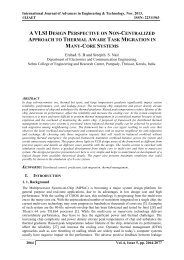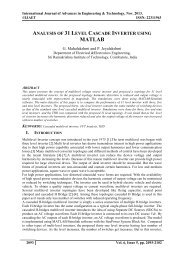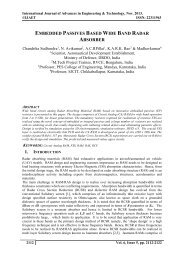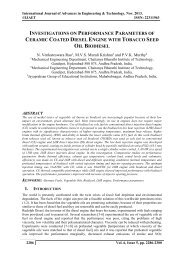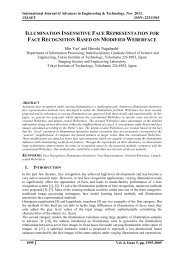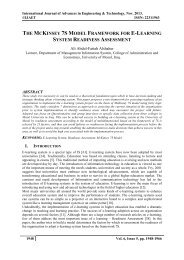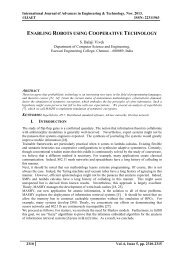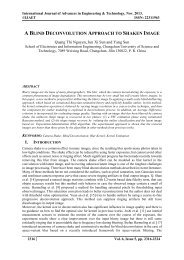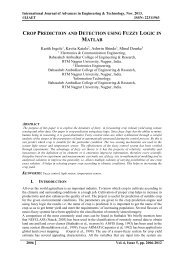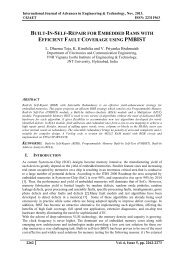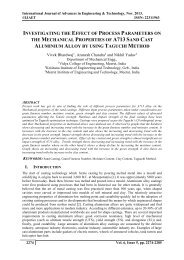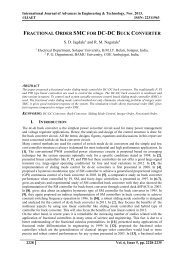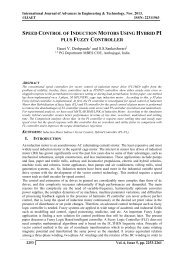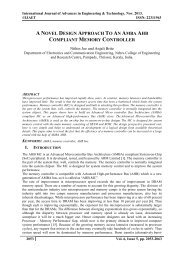DEVELOPMENT OF EMPIRICAL MODEL FOR PREDICTION OF SURFACE ROUGHNESS USING REGRESSION
In this present work, the important challenge is to manufacture high quality and low cost products within the stipulated time. The quality is one of the major factors of the product which depends upon the surface roughness and hence the surface roughness placed an important role in product manufacturing. Hence, an Empirical model is proposed for prediction of surface roughness in machining processes at given cutting conditions. The model considers the following working parameters spindle speed, feed, depth of cut, number of flutes and overhang of the tool. For a given work-tool combination, the range of cutting conditions are selected from different cutting condition variables. The experiments were conducted based on the principle of Factorial Design of Experiment (DOE) method with mixed level. After conducting experiments, surface roughness values are measured. Then these experimental results are used to develop an Empirical model for prediction of surface roughness by using Multiple Regression method. In this the Artificial Intelligence based neural network modelling approach is presented for the prediction of surface roughness of Aluminium Alloy products machined on CNC End Milling using High speed steel tool. Trails were made with different combinations of step size and momentum to select the best learning parameter. The best network structure with least Mean Square Error (MSE) was selected among the several networks. The multiple regression models, which are most widely used as prediction methods, are considered to be compared with the developed Artificial Neural Network (ANN) model performance.
In this present work, the important challenge is to manufacture high quality and low cost products within the stipulated time. The quality is one of the major factors of the product which depends upon the surface roughness and hence the surface roughness placed an important role in product manufacturing. Hence, an Empirical model is proposed for prediction of surface roughness in machining processes at given cutting conditions. The model considers the following working parameters spindle speed, feed, depth of cut, number of flutes and overhang of the tool. For a given work-tool combination, the range of cutting conditions are selected from different cutting condition variables. The experiments were conducted based on the principle of Factorial Design of Experiment (DOE) method with mixed level. After conducting experiments, surface roughness values are measured. Then these experimental results are used to develop an Empirical model for prediction of surface roughness by using Multiple Regression method. In this the Artificial Intelligence based neural network modelling approach is presented for the prediction of surface roughness of Aluminium Alloy products machined on CNC End Milling using High speed steel tool. Trails were made with different combinations of step size and momentum to select the best learning parameter. The best network structure with least Mean Square Error (MSE) was selected among the several networks. The multiple regression models, which are most widely used as prediction methods, are considered to be compared with the developed Artificial Neural Network (ANN) model performance.
You also want an ePaper? Increase the reach of your titles
YUMPU automatically turns print PDFs into web optimized ePapers that Google loves.
International Journal of Advances in Engineering & Technology, Nov. 2013.<br />
©IJAET ISSN: 22311963<br />
5.2 Artificial Neural Network Model<br />
Artificial neural networks are non-linear mapping systems and hence can be used to develop the<br />
prediction models. Neuron solution (Version 5.0) software has been used for present study. The<br />
network selected is a multilayer perception (MLP), which consists of at least three layers. The<br />
activation function used is Tan Axon function, which is a nonlinear function.<br />
5.2.1 Training of Artificial Neural Network<br />
The ANN is trained using input with corresponding output data of experimental results.<br />
Training Error:<br />
The training error i.e. MSE (Mean Square Error) is the criterion for obtaining optimum training<br />
parameter and network performance. The back propagation of error is continued for a number of<br />
iterations (Epochs) until an acceptable error level is achieved. A large number of iterations are<br />
required to back propagate the error from the output to input layer. Such process is carried out to<br />
adjust the values of weights to achieve certain estimation accuracy. The average Mean Square Error<br />
(MSE) can converge to a global or a local minimum. Generally, it is seen that the error is too high at<br />
low epochs. The error is decreased rapidly with increase in number of epochs.<br />
Selection of best size and momentum parameter:<br />
Step size (η) affects the training speed. The large η provides rapid learning but might also result in<br />
oscillation. The amount of inertia is dictated by the momentum parameter. Certain procedure is<br />
adapted to determine the best combination of step size and momentum parameter. The selected<br />
network structure is<br />
5-7-6-1 and trained with 48 training patterns with different combinations of step size ranging from 0.2<br />
to 0.8 at an increment of 0.1. The network is trained to 1,000 epochs for all the 49 combinations and<br />
the Mean Square Error (MSE) for all the 49 combinations of step size and momentum are summarized<br />
in Table 6.<br />
Table 6. Summary of various combinations of Step size and Momentum.<br />
Trail Step Momentum MSE Trail Step Momentum MSE<br />
no. size<br />
no. size<br />
1 0.2 0.2 0.003941 26 0.5 0.6 0.001687<br />
2 0.2 0.3 0.003821 27 0.5 0.7 0.002020<br />
3 0.2 0.4 0.002534 28 0.5 0.8 0.002666<br />
4 0.2 0.5 0.003349 29 0.6 0.2 0.003045<br />
5 0.2 0.6 0.003580 30 0.6 0.3 0.002857<br />
6 0.2 0.7 0.002985 31 0.6 0.4 0.002597<br />
7 0.2 0.8 0.002385 32 0.6 0.5 0.003002<br />
8 0.3 0.2 0.003243 33 0.6 0.6 0.002720<br />
9 0.3 0.3 0.002715 34 0.6 0.7 0.002624<br />
10 0.3 0.4 0.002488 35 0.6 0.8 0.001903<br />
11 0.3 0.5 0.002591 36 0.7 0.2 0.003087<br />
12 0.3 0.6 0.002992 37 0.7 0.3 0.002846<br />
13 0.3 0.7 0.002629 38 0.7 0.4 0.002644<br />
14 0.3 0.8 0.002915 39 0.7 0.5 0.002915<br />
15 0.4 0.2 0.003189 40 0.7 0.6 0.002821<br />
16 0.4 0.3 0.003259 41 0.7 0.7 0.002091<br />
17 0.4 0.4 0.002996 42 0.7 0.8 0.001714<br />
18 0.4 0.5 0.002838 43 0.8 0.2 0.002810<br />
19 0.4 0.6 0.002540 44 0.8 0.3 0.002868<br />
20 0.4 0.7 0.002568 45 0.8 0.4 0.002957<br />
21 0.4 0.8 0.002480 46 0.8 0.5 0.001411(LOW)<br />
22 0.5 0.2 0.002238 47 0.8 0.6 0.002771<br />
23 0.5 0.3 0.002837 48 0.8 0.7 0.002186<br />
24 0.5 0.4 0.002115 49 0.8 0.8 0.002340<br />
25 0.5 0.5 0.002991<br />
2047 Vol. 6, Issue 5, pp. 2041-2052




